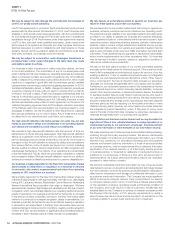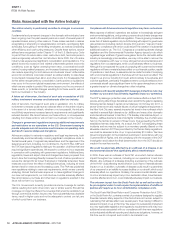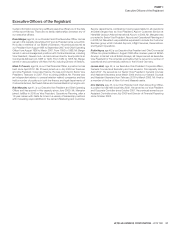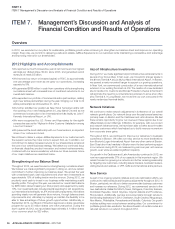JetBlue Airlines 2012 Annual Report Download - page 22
Download and view the complete annual report
Please find page 22 of the 2012 JetBlue Airlines annual report below. You can navigate through the pages in the report by either clicking on the pages listed below, or by using the keyword search tool below to find specific information within the annual report.
JETBLUE AIRWAYS CORPORATION-2012 10K18
PART I
ITEM1ARisk Factors
Risks Associated with the Airline Industry
The airline industry is particularly sensitive to changes in economic
condition.
Fundamental and permanent changes in the domestic airline industry have
been ongoing over the past several years as a result of several years of
repeated losses, among other reasons. These losses resulted in airlines
renegotiating or attempting to renegotiate labor contracts, reconfi guring fl ight
schedules, furloughing or terminating employees, as well as considering
other effi ciency and cost-cutting measures. Despite these actions, several
airlines have reorganized under Chapter11 of the U.S. Bankruptcy Code
to permit them to reduce labor rates, restructure debt, terminate pension
plans and generally reduce their cost structure. Since 2005, the U.S. airline
industry has experienced signifi cant consolidation and liquidations. The
global economic recession and related unfavorable general economic
conditions, such as higher unemployment rates, a constrained credit
market, housing-related pressures, and increased business operating costs
can reduce spending for both leisure and business travel. Unfavorable
economic conditions could also impact an airline’s ability to raise fares
to counteract increased fuel, labor, and other costs. It is foreseeable that
further airline reorganizations, consolidation, bankruptcies or liquidations
may occur in the current global recessionary environment, the effects of
which we are unable to predict. We cannot assure you the occurrence of
these events, or potential changes resulting from these events, will not
harm our business or the industry.
A future act of terrorism, the threat of such acts or escalation of U.S.
military involvement overseas could adversely affect our industry.
Acts of terrorism, the threat of such acts or escalation of U.S. military
involvement overseas could have an adverse effect on the airline industry.
In the event of a terrorist attack, whether or not successful, the industry
would likely experience increased security requirements and signifi cantly
reduced demand. We cannot assure you these actions, or consequences
resulting from these actions, will not harm our business or the industry.
Changes in government regulations imposing additional requirements
and restrictions on our operations or the U.S. Government ceasing to
provide adequate war risk insurance could increase our operating costs
and result in service delays and disruptions.
Airlines are subject to extensive regulatory and legal requirements, both
domestically and internationally, involving signifi cant compliance costs. In
the last several years, Congress has passed laws, and the agencies of the
federal government, including, but not limited to, the DOT, FAA, CBP and
the TSA have issued regulations relating to the operation of airlines that have
required signifi cant expenditures. We expect to continue to incur expenses
in connection with complying with government regulations. Additional laws,
regulations, taxes and airport rates and charges have been proposed from
time to time that could signifi cantly increase the cost of airline operations or
reduce the demand for air travel. If adopted or materially amended, these
measures could have the effect of raising ticket prices, reducing air travel
demand and/or revenue and increasing costs. The FAA has published
new regulations relating to crew rest requirements, which we are currently
analyzing. Should the fi nal rules require us to make signifi cant changes to
our crew rest requirements, our cost structure could be adversely affected.
We cannot assure you these and other laws or regulations enacted in the
future will not harm our business.
The U.S. Government currently provides insurance coverage for certain
claims resulting from acts of terrorism, war or similar events. Should this
coverage no longer be offered, the coverage that would be available to us
through commercial aviation insurers may have substantially less desirable
terms, result in higher costs and not be adequate to protect our risk, any
of which could harm our business.
Compliance with future environmental regulations may harm our business.
Many aspects of airlines’ operations are subject to increasingly stringent
environmental regulations, and growing concerns about climate change may
result in the imposition of additional regulation. There is growing consensus
some form of federal regulation may be forthcoming with respect to greenhouse
gas emissions (including carbon dioxide (CO2)) and/or “cap and trade”
legislation, compliance with which could result in the creation of substantial
additional costs to us. The U.S. Congress is considering climate change
legislation and the Environmental Protection Agency issued a rule which
regulates larger emitters of greenhouse gases. Since the domestic airline
industry is increasingly price sensitive, we may not be able to recover the
cost of compliance with new or more stringent environmental laws and
regulations from our passengers, which could adversely affect our business.
Although it is not expected the costs of complying with current environmental
regulations will have a material adverse effect on our fi nancial position, results
of operations or cash fl ows, no assurance can be made the costs of complying
with environmental regulations in the future will not have such an effect. The
impact to us and our industry from such actions is likely to be adverse and
could be signifi cant, particularly if regulators were to conclude emissions from
commercial aircraft cause signifi cant harm to the upper atmosphere or have
a greater impact on climate change than other industries.
Compliance with recently adopted DOT passenger protections rules may
increase our costs and may ultimately negatively impact our operations.
The DOT’s passenger protection rules, which became effective in April 2010,
provide, among other things, that airlines return aircraft to the gate for deplaning
following tarmac delays in certain circumstances. On October29, 2011, a
severe winter storm and multiple failures of critical navigational equipment in
the New York City area, severely impacted air travel in the northeast which
resulted in several fl ight diversions by JetBlue and many other domestic
and international carriers to Hartford, CT’s Bradley International Airport, or
Bradley. JetBlue diverted a total of six fl ights to Bradley, fi ve of which were
held on the tarmac in excess of three hours, thus exceeding the DOT’s
established tarmac delay limits. As a result, the DOT is investigating these
incidents and we may be subject to a monetary penalty. Based on the
allowable maximum DOT fi ne proscribed by the Tarmac Delay regulations,
we could be assessed a fi ne of up to approximately $15 million. We have
issued compensation to the impacted customers in accordance with our
Customer Bill of Rights, and are complying with the requests of the DOT
investigation and believe the fi nal determination from the DOT should be
made in the next few months.
We could be adversely affected by an outbreak of a disease or an
environmental disaster that signifi cantly affects travel behavior.
In 2009, there was an outbreak of the H1N1 virus which had an adverse
impact throughout our network, including on our operations to and from
Mexico.Any outbreak of a disease (including a worsening of the outbreak
of the H1N1 virus) affecting travel behavior could have a material adverse
impact on us.In addition, outbreaks of disease could result in quarantines
of our personnel or an inability to access facilities or our aircraft, which could
adversely affect our operations. Similarly, if an environmental disaster were
to occur and adversely impact any of our destination cities, travel behavior
could be affected and in turn, could materially adversely impact our business.
The unknown impact from the Dodd-Frank Act as well as the rules to
be promulgated under it could require the implementation of additional
policies and require us to incur administrative compliance costs.
The Dodd-Frank Wall Street Reform and Consumer Protection Act of 2010,
or the Dodd-Frank Act, contains a variety of provisions designed to regulate
fi nancial markets. Many aspects of the Dodd-Frank Act remain subject to
rulemaking that will take effect over several years, thus making it diffi cult to
assess its impact on us at this time. We expect to successfully implement
any new applicable legislative and regulatory requirements and may incur
additional costs associated with our compliance with the new regulations
and anticipated additional reporting and disclosure obligations; however, at
this time we do not expect such costs to be material to us.
























